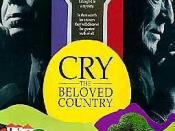The family in Cry, the Beloved Country involves themes emphasizing the home and family. From the James Earl Jones seeking for his son to the other priest searching and wanting a place of her own, this movie shows how one reacts to the attraction of home and family. The home symbolizes a place of refuge and belonging which are exhibited throughout the movie as James Earl Jones searches for his lost son. It gives the movie viewer the sense of refuge and belonging to be with their family.
It introduces Jones as the protagonist and sets up the framework for the conflicts he soon encounters. Johannesburg acts as both the setting and the antagonist, for it is where racism, crime, and poverty dwell, and is the source of Jones' misery. Jones discovers his sister's prostitution, his brother's superficiality, and his son's criminal activities in Johannesburg show the city to have entrapped his family, as well as its inhabitants, into a stage of declining morality.
The climatic scene occurs when Jones and Jarvis meet for the first time, representing the confrontation of emotion and tension each person has felt since their discovery of the murder. Jones is trying to show Jarvis that both are grieving over their sons and are in similar circumstances. This confrontation signifies the parallel between the two men's lives. They attempt to come to a resolution in hopes of reconciling their differences. Factors, such as the prevalence of racism and the irony that his murdered son was a defender of the social injustices of natives, support Jarvis' hatred for James Earl Jones. Jarvis acknowledges the good intentions of Jones as a pastor. Jarvis' generosity in rebuilding the church, cultivating the land, and improving the lifestyle of Kumalo's village signifies his carrying on of his son's legacy...


